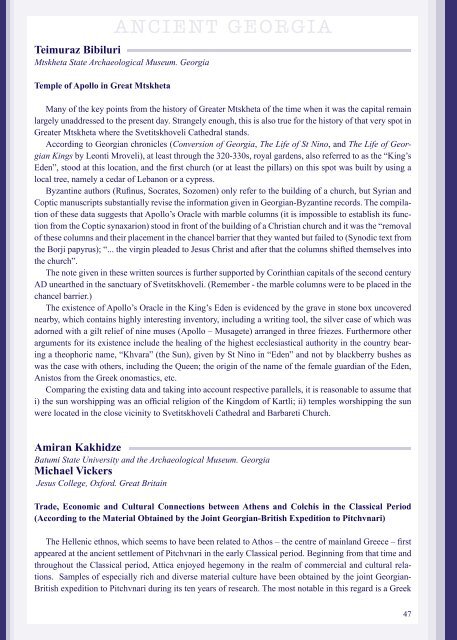Abstracts - International Initiative for Georgian Cultural Studies
Abstracts - International Initiative for Georgian Cultural Studies
Abstracts - International Initiative for Georgian Cultural Studies
You also want an ePaper? Increase the reach of your titles
YUMPU automatically turns print PDFs into web optimized ePapers that Google loves.
ANCIENT GEORGIA<br />
Teimuraz Bibiluri<br />
Mtskheta State Archaeological Museum. Georgia<br />
Temple of Apollo in Great Mtskheta<br />
Many of the key points from the history of Greater Mtskheta of the time when it was the capital remain<br />
largely unaddressed to the present day. Strangely enough, this is also true <strong>for</strong> the history of that very spot in<br />
Greater Mtskheta where the Svetitskhoveli Cathedral stands.<br />
According to <strong>Georgian</strong> chronicles (Conversion of Georgia, The Life of St Nino, and The Life of <strong>Georgian</strong><br />
Kings by Leonti Mroveli), at least through the 320-330s, royal gardens, also referred to as the “King’s<br />
Eden”, stood at this location, and the first church (or at least the pillars) on this spot was built by using a<br />
local tree, namely a cedar of Lebanon or a cypress.<br />
Byzantine authors (Rufinus, Socrates, Sozomen) only refer to the building of a church, but Syrian and<br />
Coptic manuscripts substantially revise the in<strong>for</strong>mation given in <strong>Georgian</strong>-Byzantine records. The compilation<br />
of these data suggests that Apollo’s Oracle with marble columns (it is impossible to establish its function<br />
from the Coptic synaxarion) stood in front of the building of a Christian church and it was the “removal<br />
of these columns and their placement in the chancel barrier that they wanted but failed to (Synodic text from<br />
the Borji papyrus); “... the virgin pleaded to Jesus Christ and after that the columns shifted themselves into<br />
the church”.<br />
The note given in these written sources is further supported by Corinthian capitals of the second century<br />
AD unearthed in the sanctuary of Svetitskhoveli. (Remember - the marble columns were to be placed in the<br />
chancel barrier.)<br />
The existence of Apollo’s Oracle in the King’s Eden is evidenced by the grave in stone box uncovered<br />
nearby, which contains highly interesting inventory, including a writing tool, the silver case of which was<br />
adorned with a gilt relief of nine muses (Apollo – Musagete) arranged in three friezes. Furthermore other<br />
arguments <strong>for</strong> its existence include the healing of the highest ecclesiastical authority in the country bearing<br />
a theophoric name, “Khvara” (the Sun), given by St Nino in “Eden” and not by blackberry bushes as<br />
was the case with others, including the Queen; the origin of the name of the female guardian of the Eden,<br />
Anistos from the Greek onomastics, etc.<br />
Comparing the existing data and taking into account respective parallels, it is reasonable to assume that<br />
i) the sun worshipping was an official religion of the Kingdom of Kartli; ii) temples worshipping the sun<br />
were located in the close vicinity to Svetitskhoveli Cathedral and Barbareti Church.<br />
Amiran Kakhidze<br />
Batumi State University and the Archaeological Museum. Georgia<br />
Michael Vickers<br />
Jesus College, Ox<strong>for</strong>d. Great Britain<br />
Trade, Economic and <strong>Cultural</strong> Connections between Athens and Colchis in the Classical Period<br />
(According to the Material Obtained by the Joint <strong>Georgian</strong>-British Expedition to Pitchvnari)<br />
The Hellenic ethnos, which seems to have been related to Athos – the centre of mainland Greece – first<br />
appeared at the ancient settlement of Pitchvnari in the early Classical period. Beginning from that time and<br />
throughout the Classical period, Attica enjoyed hegemony in the realm of commercial and cultural relations.<br />
Samples of especially rich and diverse material culture have been obtained by the joint <strong>Georgian</strong>-<br />
British expedition to Pitchvnari during its ten years of research. The most notable in this regard is a Greek<br />
47



